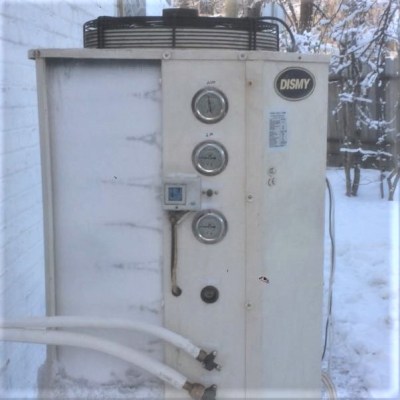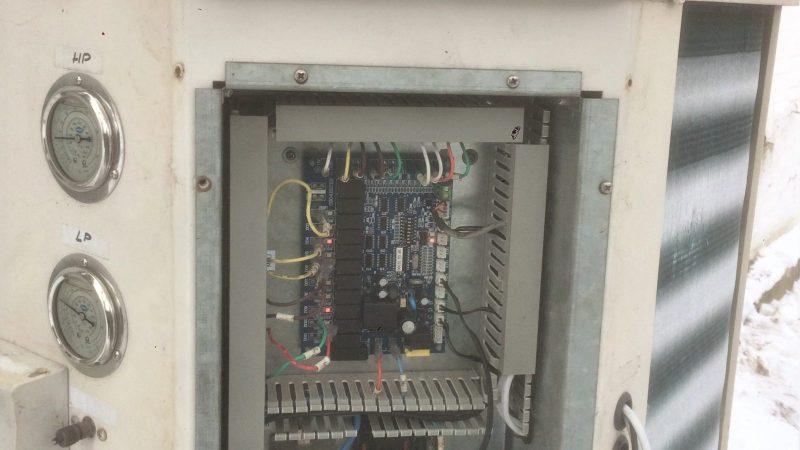If you buy a used heat pump that was made in China and try to use it in Northern Europe, there are bound to be issues. If said heat pump ends up encased in a block of ice that renders it ineffective, you’ve got two choices: give up and buy a proper heater, or hack a new ice-busting brain board into the heat pump and get back to life.

[Evalds] chose the latter course, obviously, and in the process he gives us a pretty good look at how heat pumps work and how to overcome their deficiencies. In [Evalds]’ Latvia, winters can be both cold and humid, which can worsen an inherent problem with air-coupled heat pumps: they tend to ice up. As the outside coil is cooled to pick up as much heat as possible from the outside air, water vapor condenses out on the coils and freezes. Most heat pumps account for this by occasionally running in reverse, heating the outdoor coils to clear the ice buildup. [Evalds]’ had nothing more than a simple timer to kick off the defrost cycle, and it wasn’t keeping up with the Latvian winter. An Arduino replaced the OEM controller, and wired up to temperature sensors and an IR sensor that watches for ice buildup on the lower part of the coil, the heat pump is now much better behaved.
Of course it wasn’t as smooth as all that — [Evalds] has some hoops to jump through, including EMI problems and a dodgy Arduino clone. But he stuck with it and brought the heat pump back online, likely at far less expense than HVAC techs would charge for a service call.
















I am just about to embark on a similar project, I live in Florida and am building an arduino thermostat for my analog window unit in my shop that will have digital temp control + will cycle the unit based off of humidity to maintain low humidity inside.
I need this for my indoor ground-source heat pump too. Even indoors, the humidity can get away on you and freeze up the unit, and it has no way to detect that and shut off. Arduino + IR sensor would help!
In the function as heat pump it should heat the indoor coils and not cause freezing. Or is your heat pump capable of reverse cycle as an air conditioner? Then this would make sense.
You can avoid icing by keeping the evaporator above the dew point temperature. That would require a variable frequency drive for the compressor and a feedback loop.
The dew point is dependent on the relative humidity, so measuring that allows you to tell how far below ambient temperature you can run it. There’s no point in running the system to ice because you lose just as much energy in defrosting.
But, if you can remove all the ice without melting it, that allows you to extract the energy released on condensation and that would actually improve the heat pump performance. An icemaker is basically a geothermal heat pump, since it takes in water heated by the ground, extracts the energy and releases it to the room, and then spits out ice cubes. If you toss the ice cubes out the window, you end up with a lot more heat in the room than the electricity consumed by the machine.
In our climate zone, it is not possible to avoid ice just by optimizing evaporator temperature/pressure, because it will accumulate ice anyway at moist air around -5 till +5 deg. Celsius
Then I don’t see a point in running the heat pump. Under icing conditions the effective CoP should be close to 1 because you have to defrost it, so it’s just as well you don’t run it at all.
Ice is an insulator that prevents the heat exchanger from picking up ambient heat, so as soon as the surfaces are frosted the system is little better than a straight up resistive heater. It gets some amount of energy from the condensation and freezing of water, but it loses that same amount when you defrost it.
Though at positive air temperatures it still makes sense, because the defrosting comes free, or just at the cost of running a fan.
You are right about icing conditions and CoP 1
To be more specific, when the relative humidity is 100% that means the dew point is the same as the ambient air temperature and anything that is not warmer will gather frost. Under 100% relative humidity, air-to-air heatpumps simply don’t work because they freeze over instantly.
It won’t be 15 minutes before the heat exchanger is completely covered in a layer of insulating frost and 99% of the power output is due to heat from the pumping losses.
As the relative humidity drops below 100%, you always get a temperature margin where the evaporator can be slightly below ambient air without accumulating frost. By reducing the power throughput, you can maintain efficiency at the expense of heat output, or maintain heat output at the expense of efficiency. The harder you run it, the faster the frost accumulates and the faster the coefficient of power drops to 1.
In my experience consumer ASHP manufacturers who favor overly conservative frost control cycles to the strong detriment of cold weather performance.
“As the outside coil is cooled to pick up as much heat as possible from the outside air,”
*facepalm*
Thermodynamics explanation Fail…
Hey, I said the temperature of the coil is dropped by reducing the pressure of the freon. Anyway don’t be harsh on my explanation, I made a way so that it would be as easy as possible to understand heat & defrost cycle by leaving out many details.
Given that English is likely a second or third language for you, I think you explained it well enough. Some people just like to nitpick.
Anyway, great writeup, and thanks for sharing your work.
Water taken from the tap at +15 C and frozen to -0C will release almost exactly 500 kJ of energy per kg, which makes a bucket of water worth ~1 kWh of heat.
A good heat pump will release that heat at room temperature at a CoP of 10, so freezing a barrel of water will give you about 20 kWh of heat at the cost of 2 kWh in electricity, or roughly 1 cents per kWh at US average electricity prices. In comparison, natural gas costs 5-6 cents per kWh heat.
Now the task is to design a system that automatically fills a barrel of water inside a chest freezer, extracts the heat, and then rolls it out the back door. Bonus points if you drop it in the basement and thaw it using the water from the shower, so it can be re-used.
What part of the US do you think has $0.01/kWh?
forgot the link to EIA data on electricity: http://www.eia.gov/electricity/
I believe Dax is saying that by getting 20KWh of thermal energy from 2KWh of electrical energy, it’s like paying 1/10th the price. So, if your electricity is 10c/KWh you’ll get 1KWh of heat for 1 cent.
I’ll be honest, I have gas heat and only thought that heat pumps only made sense for folks using electrical heating. I’ll have to figure out how to convert therms to KWh (minus losses up the flue) and see where the break even is with 5c savings.
My parents installed a geothermal system about five years ago; they tell me that they’re paying about the same amount of money in the winter (relative to heating oil), and the big savings come in the summer (relative to an air-to-air heat pump for cooling)
In warmer climates (particularly those where A/C is more or less required), good heat pumps have already overtaken gas heat in economics. In fact, even if gas calculates ahead, the service charge for gas can put it at a disadvantage in some cases.
Precisely.
The exact energy you get out of a barrel of water (164 L) is 22 kWh from +15 to frozen. Add 2 kWh worth of electricity to the mix and your total heat output is 24 kWh. 2 kWh of electricity at the US average 11 c/kWh is 22 cents, so it’s 0.91 c/kWh for heat.
The only question is how to thaw the block of ice that results, for free, because otherwise you run up your water bill and get a pile of frozen barrels on your back yard by the end of winter.
Info on effectiveness – during this winter I observed following for 35m^2 apartment + hot water it consumed electricity:
at -15*C = 20kW per 24h
at 0*C = 30kW per 24h
at 5*C = 10kW per 24h
Still tuning the system, but for extremely cheap hardware overall price is good in my opinion. Of course not as effective as gas heating, but it would cost +15000EUR/USD for us to connect to gas provider here..
What is kW per 24h?
I meant kWh :)
If you’re ever around the Baltic and you see what looks like a window air conditioner half-running incased in ice in a blizzard attached to at least every third building’s side.. Yeah for some reason this is current technology in countries like Latvia and Estonia where the education standards are higher but then stuff like this..
Considering all costs of this particular hardware + setup + running costs, I am happy with this hacked solution :)